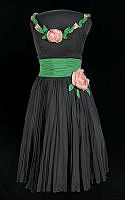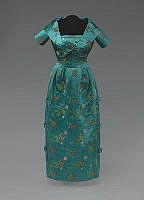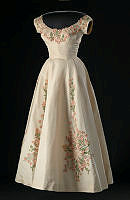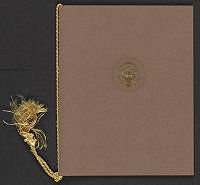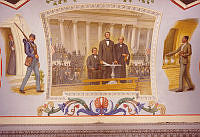Rubenstein Center Scholarship
The First Ladies and Slavery
This article is part of the Slavery in the President’s Neighborhood initiative. Explore the Timeline
Most Americans do not associate the first ladies with slave ownership. In fact, it may be surprising to learn that slavery was a significant aspect of the identities and lifestyles of one-third of the women who have held the role since the nation’s founding. Thirteen first ladies or White House hostesses— nieces, daughters, and sisters, who took the place of ill or deceased presidential wives— were born into slave owning families:
- Martha Washington
- Abigail Adams
- Martha Jefferson Randolph
- Dolley Madison
- Elizabeth Monroe
- Louisa Catherine Adams
- Emily Donelson
- Angelica Singleton Van Buren
- Letitia Christian Tyler
- Sarah Polk
- Margaret Taylor
- Mary Todd Lincoln
- Julia Grant 1
Four others married into slave ownership or became slave owners later in life:
At least nine presidential administrations eventually relied on enslaved labor while living at the White House.
Like their husbands, these first ladies benefitted from enslaved labor daily, and often shared a more intimate relationship with slavery than their spouse. The legality of female slave ownership depended upon location and time, and many first ladies managed enslaved servants whom they did not technically own. Still, white women played an important role in the management of enslaved labor—particularly those enslaved servants who worked within the home.

This painting by Edward Savage, titled The Washington Family (1789-1796), shows the Washingtons at their Mount Vernon estate. It is rare, as there is an enslaved servant depicted in the background of the painting. Indeed, the Washingtons would have been surrounded by enslaved servants in their home.
Andrew W. Mellon Collection, National Gallery of ArtUpbringing and Marriage
Martha Washington set many precedents for the role of first lady, including the normalization of owning and controlling enslaved individuals. Born into the Virginia elite, Martha Dandridge grew up in a wealthy, slave owning family. Her first husband, Daniel Parke Custis, owned “five plantations and nearly three hundred” enslaved men, women, and children, but died prematurely in 1757.2 According to his will, Martha was entitled to use (but not legally own) one-third of her husband’s property, including enslaved laborers and domestic servants, who became part of George Washington’s Mount Vernon workforce when the couple married in 1759.3 Mrs. Washington also expressed racist opinions throughout her life, writing in 1795 that “Black children are liable to so many accidents and complaints—that one is heardly sure of keeping them…the Blacks are so bad in thair nature that they have not the least Gratatude for the kindness that may be shewed to them.”4
Many of Martha’s successors in the role of first lady also grew up around the institution of slavery, benefitting from the practice of bondage from cradle to grave, though not all of the first ladies mentioned above lived on plantations. Slavery also abounded in urban areas, where enslaved domestic servants worked in the homes of politicians, merchants, and business owners. Elizabeth Monroe’s father, Lawrence Kortright, owned several enslaved individuals in New York City in the late eighteenth century, and Mary Todd Lincoln’s father, Robert Smith Todd, owned between three and eight enslaved domestic servants at their Lexington, Kentucky townhouse during her childhood.5 Though urban slavery was very different from plantation slavery, enslaved individuals remained unfree and quite restricted in their movements outside of their owner’s home.
In They Were Her Property: White Women as Slave Owners in the American South, historian Stephanie E. Jones-Rogers outlines the important lessons that young white women learned as they grew up in slave owning households, including how to manage enslaved populations, instill discipline, and implement various forms of punishment.6 Furthermore, they often became “mistresses” at a young age. Some girls were gifted a young enslaved companion to grow up with, willed enslaved property by their father, or raised in part by enslaved nurses. Mary Todd Lincoln was raised by an enslaved woman called “Mammy” Sally, while Julia Dent Grant grew up playing “with a dusky train of from eight to ten little colored girls of all hues,” owned by her father, Frederick Dent.7 As a result, white children from slave owning families were familiar with enslaved individuals before they were taught to assume authority over them in adulthood. Many white women perpetuated this cycle later in life, handing their children and grandchildren over to be reared by enslaved nurses.
Some first ladies were more closely linked to the enslaved children owned by their parents. For example, an enslaved man named James Hambleton Christian claimed to be half-brother to Letitia Christian Tyler, later held in bondage as a servant to his own kin at the White House.8 James self-emancipated via the Underground Railroad, though his fate is unknown.9 Similarly, President Thomas Jefferson’s daughters, including occasional White House hostess Martha Jefferson Randolph, were the half-sisters of the children born to Jefferson and Sally Hemings. Despite being Jefferson’s biological children, they were enslaved because of Hemings’ status as an enslaved woman.10 These complicated relationships blurred the lines between family and property. Nevertheless, white slave owners assumed dominance over enslaved individuals with whom they shared blood and never truly considered them “family.”

This sketch depicts Elias Polk, an enslaved man who served in the Polk White House. Sarah Polk’s father gave Elias to Sarah and James as a wedding gift.
Courtesy of the President James K. Polk Home & Museum, Columbia, TennesseeGrowing up in a slave owning family also influenced the skillset and lifestyle of the young women who would later become first ladies. By being served from an early age, many never learned basic household chores. Julia Dent Grant, who grew up on White Haven plantation in Missouri, mused in her memoir that as an adult, she did not know how to properly prepare biscuits: “I presume that the cook would have done better if I had ever prepared any before… I had only cut out small cakes with my thimble from the dough prepared by my black Mammy.”11 Accustomed to a life of privilege after marrying into slave ownership, Dolley Madison once complained to her sister that her enslaved lady’s maid, Sukey, had stolen from her. Mrs. Madison wrote that it was “terribly inconvenient to do without her—so I must even let her steal from me, to keep labor from myself.”12 The skills expected of a proper wife in the nineteenth century—namely, cooking, cleaning, and raising children—could be largely avoided if supplanted by enslaved labor.
This dependency had no impact on a woman’s marriage prospects. In fact, a slave owning woman’s dowry, inheritance, and social status—which often included enslaved property— typically improved the number and quality of suitors upon reaching adulthood. Angelica Singleton Van Buren came from one of the wealthiest slave owning families in South Carolina—the Singletons—which enabled her to make a shrewd match with Abraham Van Buren, son of President Martin Van Buren. In addition to Angelica’s large dowry, the Van Burens gained a crucial political tie to America’s southern elite in the antebellum period.13 Similarly, other nineteenth-century first ladies were economically-lucrative partners who came from very wealthy slave owning families, including Sarah Childress Polk, Letitia Christian Tyler, and Margaret Taylor. Perhaps more importantly, the inherited wealth of some first ladies, including plantation acreage, enslaved individuals, and wealth accumulated from enslaved labor, allowed their husbands to pursue a career in politics and public service. Generally speaking, plantations provided a fairly consistent form of income for absent slave owners, even while living at the White House.

Dolly, an enslaved servant of Andrew and Eliza Johnson, is pictured here with their grandson, Andrew Johnson Stover. It was common for enslaved women to nurse the children of their owners.
Courtesy of the Andrew Johnson National Historic Site, National Park ServiceWhile their husbands worked, slave owning first ladies often remained at home, where they benefitted from and oversaw enslaved labor from dawn to dusk. In the absence of their husbands, slave owning women also occasionally managed finances and household discipline. The Johnsons, for example, sometimes hired out their enslaved servants to neighbors in Greeneville, Tennessee; on one occasion, Sam, their enslaved servant, demanded payment from Eliza Johnson for chopping wood. She responded that “if he was as ready to pay others as he was to collect, he would do better,” simultaneously denying his pay and reminding him of his status.14
Slave owning women would also be woken, dressed and groomed by enslaved lady’s maids, warmed by fires tended by enslaved individuals, and served food and drink from the hands of enslaved cooks and butlers. Enslaved nurses cared for their children throughout the day, freeing time for entertainment and pursuit of hobbies like needlepoint, reading, and music. This life of privilege prepared them well for the position of first lady and White House hostess.

Sam Johnson, an enslaved man owned by the Johnson family, was disciplined by Eliza Johnson for seeking payment.
Courtesy of the Andrew Johnson National Historic Site, National Park ServiceThe White House
Upon moving into the White House, a first lady’s essential duties relied upon a dependable workforce to support the maintenance and operation of the Executive Mansion. Part of the responsibilities of a nineteenth-century wife were household management and the supervision of workers, whether free or enslaved. The maintenance of the White House was laborious and expensive, so the exploitation of enslaved servants was financially lucrative for the first family. To curb the president’s power and avoid the trappings of monarchy, Congress controlled funding for White House furnishings and building projects. Meanwhile, the president was expected to pay for events, food, and labor from their own pocket. As a result, many chose to use enslaved labor, rather than paying for servants from their already meager salary. To save money, Sarah Polk fired “the baker and the chef…along with a steward who had worked at the White House for twenty years and a handful of other experienced domestic workers.”15 In their place, Mrs. Polk brought in a few of her own enslaved servants. She also used free and enslaved African-American laborers as needed, including Paul Jennings, an enslaved man owned by the Madisons and briefly hired out to the Polks during their tenure at the White House.16
First ladies also managed social events and entertainment at the White House, made possible by enslaved cooks, butlers, and lady’s maids, among others.17 Perhaps the most famous example of this is Dolley Madison. According to historian Marie Jenkins Schwartz, Dolley’s weekly squeezes and balls “required a lot of work from the Madison slaves, who were highly visible to guests…their number equaled, even exceeded, the number of diners, for Dolley appointed a servant to stand behind each guest at dinner parties.”18

Paul Jennings was hired out by the Madisons to work at the Polk White House–a financially lucrative situation for both parties.
The Estate of Sylvia Jennings AlexanderAndrew Jackson’s daughter-in-law, Sarah Yorke Jackson, shared hostess duties with Jackson’s niece, Emily Donelson, and relied heavily on enslaved servants Louisa and Gracy Bradley, who served as seamstresses, lady’s maids, and nurses for Sarah’s children.19 Without the additional time constraints of childcare, Sarah Yorke Jackson could instead focus on the social season and a full calendar as White House hostess.
Jackson purchased Gracy and Louisa together with their sister Rachel and their mother Nancy, but the latter were sent to work at Jackson’s Tennessee plantation, The Hermitage.20 The separation of families was common among enslaved servants brought to the White House, adding to the emotional toll of living in bondage.
Enslaved labor was so ubiquitous in nineteenth-century Washington, D.C. that some first ladies who were morally opposed to the institution of slavery still benefitted from its existence while living at the White House. Abigail Adams denounced slavery, but observed its frequent use in the neighborhood, writing that “the effects of Slavery are visible every where [in Washington, D.C.]; and I have amused myself from day to day in looking at the labour of 12 negroes from my window, who are employd with four small Horse Carts to remove some dirt in front of the house.”21 Louisa Catherine Adams, wife of outspoken antislavery politician John Quincy Adams, allowed an enslaved girl named Rachel Clark, owned by her niece to live and labor in bondage at the White House.22 These interactions show that even antislavery first families who did not endorse the institution of slavery sometimes benefitted from it depending on the circumstances and familial inheritances in question.

Receipt for Gracy Bradley in Andrew Jackson’s bank book. Gracy was an enslaved nurse, seamstress, and lady's maid to Sarah Yorke Jackson, White House hostess.
Library of Congress, Manuscript DivisionAfter the White House
In contrast, Julia Gardiner Tyler, President John Tyler’s second wife, was a Northerner who fully embraced the lifestyle of a slave mistress. After moving from the White House to Tyler’s Sherwood Forest plantation in Virginia, she became a Southern slave owner who publicly defended the institution of slavery in an 1853 response to the Duchess of Sutherland, a British abolitionist.23 Julia wrote: “Leave it to the women of the South to alleviate the sufferings of their own dependents while you take care of your own. The negro of the South lives sumptuously in comparison with the 100,000 of the white population in London. He is clothed warmly in winter, and has his meat twice daily…”24 This benevolent view of slavery was common among American first ladies, presidents, and enslavers in general. There are very few written accounts of the experiences of enslaved individuals, but it is clear from other sources that the so-called cheerful, familial relationships between slave owners and enslaved laborers were heavily one-sided. Kindness was no replacement for freedom—evidenced by the self-emancipation of several enslaved people owned by presidents and first ladies.25
In many cases, American first ladies inherited the enslaved individuals owned by their husbands following their deaths or were permitted to utilize the enslaved laborers until their own passing. One of Dolley Madison’s final acts was to sell her husband’s Montpelier estate to Henry Moncure, splitting up the enslaved community there in order to settle her debts and fragmenting numerous families in the process.26 A heartbreaking example of this is the story of Ellen—the youngest daughter of Madison’s lady’s maid, Sukey. When Ellen learned of intentions to sell her in 1848, she took matters into her own hands and joined 76 other enslaved individuals escaping to freedom on the Potomac River. Unfortunately, the plans were foiled and their schooner, the Pearl, was caught. As punishment, many were sold to the deep South. However, abolitionists paid for Ellen’s freedom. In retribution for Ellen’s self-emancipation, Dolley Madison sold Sukey, separating mother and daughter forever.28

Newspaper advertisement for the return of Ona "Oney" Judge, Martha Washington's enslaved lady's maid, who escaped from the President's Mansion in Philadelphia. Judge was never caught, and died a free woman.
Philadelphia GazetteDolley’s actions cruelly defied James Madison’s will, which stated: “I give and bequeath my ownership in the negroes and people of colour held by me to my dear Wife, but it is my desire that none of them should be sold without his or her consent or in the case of their misbehaviour…”29
Likewise, Martha Washington chose to will the only enslaved man she personally owned, Elish, to her “grand-son, George Washington Parke Custis…and his heirs forever,” unlike George Washington, who freed the individuals he enslaved upon his death.30 This example underscores another crucial part of understanding slave owning first ladies—they did not always share the opinions held by their husbands on the subject. Though George Washington’s stance on human bondage evolved over time, Martha Washington ensured the continuity of the institution in her will.
In the end, some first ladies, like Dolley Madison, Sarah Polk, and Julia Grant were highly involved in managing their own enslaved households, while others, like Abigail Adams and Louisa Catherine Adams, were less enthusiastic participants in the institution. Nevertheless, all American first ladies have been touched by slavery in some way, even if only through their temporary residence in the White House—as First Lady Michelle Obama aptly noted: “I wake up every morning in a house that was built by slaves.”


